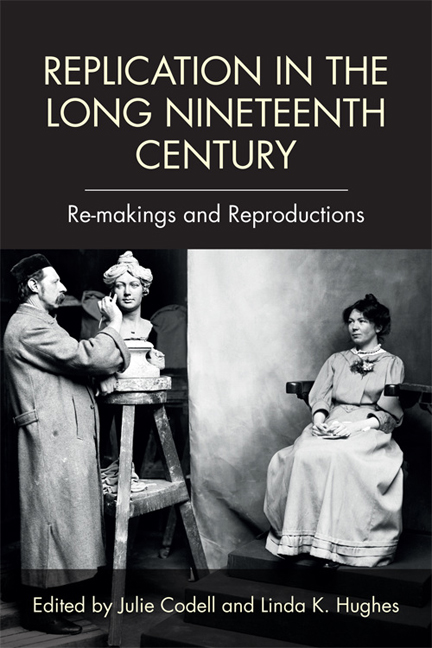Book contents
- Frontmatter
- Contents
- List of Illustrations
- Acknowledgments
- 1 Introduction: Replication in the Long Nineteenth Century – Re-makings and Reproductions
- I Replication and Networks
- II Replication and Technology
- III Replication and Authenticity
- 10 Literary Replication and the Making of a Scientific “Fact”: Richard Owen's Discovery of the Dinornis
- 11 Copying from Nature: Biological Replication and Fraudulent Imposture in Grant Allen's An African Millionaire
- 12 The Failure of Replication in Nineteenth-Century Literature: Why It All Just Comes Out Wrong
- IV Replication and Time
- Notes on Contributors
- Index
10 - Literary Replication and the Making of a Scientific “Fact”: Richard Owen's Discovery of the Dinornis
from III - Replication and Authenticity
Published online by Cambridge University Press: 11 August 2018
- Frontmatter
- Contents
- List of Illustrations
- Acknowledgments
- 1 Introduction: Replication in the Long Nineteenth Century – Re-makings and Reproductions
- I Replication and Networks
- II Replication and Technology
- III Replication and Authenticity
- 10 Literary Replication and the Making of a Scientific “Fact”: Richard Owen's Discovery of the Dinornis
- 11 Copying from Nature: Biological Replication and Fraudulent Imposture in Grant Allen's An African Millionaire
- 12 The Failure of Replication in Nineteenth-Century Literature: Why It All Just Comes Out Wrong
- IV Replication and Time
- Notes on Contributors
- Index
Summary
The nineteenth-century press's perpetual reprinting of extracts, abstracts, and other forms of syndicated text has been termed “literary replication” by the historian of science James Secord. Emphasizing how, in this complex process, “textual stability” is “difficult to achieve,” Secord proposes that reprinted texts often become radically unstable and are denuded of the same range of meanings they previously held (126). Such instability might even be assumed to be a necessary component of Secord's model of literary replication, with the book historian Leslie Howsam, for instance, suggesting the “metaphor” that “like cells, texts replicate themselves, but with variants” (3). As I will demonstrate, however, the original meanings of reprinted texts do not inevitably mutate and can instead be retained, albeit with a great deal of supervision and even some morally dubious journalistic practices. The particular instance of literary replication I explore is that which occurred in the wake of Richard Owen's identification of the extinct struthious bird named the dinornis, or moa as it was called in indigenous traditions, whose discovery in 1839 was widely hailed as one of the greatest scientific accomplishments of the nineteenth century.
What was striking about Owen's discovery of the dinornis was that he predicted its erstwhile existence in New Zealand from only a broken piece of femur bone. Owen contended that his extraordinary prediction was accomplished through the law of correlation. This law, which had been formulated by Georges Cuvier in the 1790s, proposed that each element of an animal corresponds mutually with all the others, so that a carnivorous tooth must be accompanied by a particular kind of jawbone, neck, stomach, and so on that facilitates the consumption of flesh, and equally cannot be matched with bones and organs adapted to a herbivorous diet. As such, a single part, even the merest fragment of bone, necessarily indicates the configuration of the whole. Owen's identification of the dinornis from a single “fragment of bone” was soon eulogized by his contemporaries as the “most striking and triumphant instance of the sagacious application of the principles of the correlation of organic structure enunciated by the illustrious Cuvier,—the one that may be regarded as the experimentum crucis of the Cuvierian philosophy” (Mantell 225–6). There was, however, a problem with Owen's putative triumph of inductive reasoning.
- Type
- Chapter
- Information
- Replication in the Long Nineteenth CenturyRe-makings and Reproductions, pp. 181 - 194Publisher: Edinburgh University PressPrint publication year: 2017



